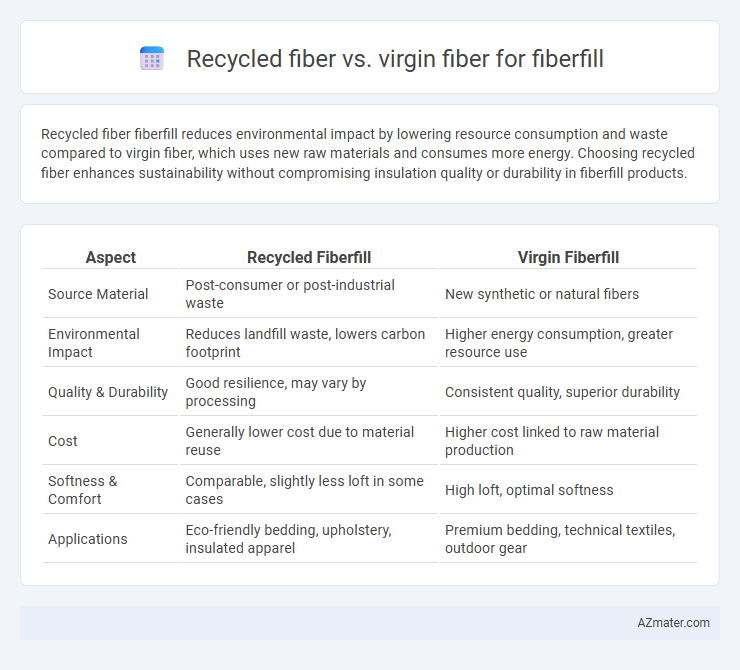Recycled fiber fiberfill reduces environmental impact by lowering resource consumption and waste compared to virgin fiber, which uses new raw materials and consumes more energy. Choosing recycled fiber enhances sustainability without compromising insulation quality or durability in fiberfill products.
Table of Comparison
| Aspect | Recycled Fiberfill | Virgin Fiberfill |
|---|---|---|
| Source Material | Post-consumer or post-industrial waste | New synthetic or natural fibers |
| Environmental Impact | Reduces landfill waste, lowers carbon footprint | Higher energy consumption, greater resource use |
| Quality & Durability | Good resilience, may vary by processing | Consistent quality, superior durability |
| Cost | Generally lower cost due to material reuse | Higher cost linked to raw material production |
| Softness & Comfort | Comparable, slightly less loft in some cases | High loft, optimal softness |
| Applications | Eco-friendly bedding, upholstery, insulated apparel | Premium bedding, technical textiles, outdoor gear |
Introduction to Fiberfill: Recycled vs Virgin Fiber
Fiberfill produced from recycled fiber offers a sustainable alternative to virgin fiber by reducing waste and conserving natural resources through the reuse of materials such as plastic bottles and textile scraps. Virgin fiber, derived from newly harvested synthetic polymers or natural sources, provides consistent quality and performance but involves higher energy consumption and environmental impact in production. Comparing recycled fiber and virgin fiber highlights the trade-offs between sustainability benefits and material purity in fiberfill applications for insulation, cushioning, and padding in textiles and bedding products.
What is Recycled Fiber? Key Characteristics
Recycled fiber for fiberfill is made from post-consumer or post-industrial waste, such as plastic bottles or fabric scraps, processed to create new filling material. Key characteristics include sustainability, reduced environmental impact, and lower energy consumption compared to virgin fiber, while maintaining comparable insulation and cushioning properties. These fibers often exhibit slight variations in texture and color but provide an eco-friendly alternative for textile and upholstery applications.
Defining Virgin Fiber: Properties and Sources
Virgin fiber refers to fibers obtained directly from natural sources such as wood pulp, cotton, or wool, which have not undergone previous processing or recycling. These fibers exhibit superior strength, uniformity, and cleanliness compared to recycled fibers, making them ideal for high-quality fiberfill applications requiring durability and loft retention. Common sources of virgin fiber for fiberfill include sustainably harvested trees for cellulose-based fibers and newly harvested cotton or wool from livestock farms.
Environmental Impact: Recycled vs Virgin Fiber
Recycled fiber used in fiberfill significantly reduces environmental impact by lowering water consumption, energy usage, and greenhouse gas emissions compared to virgin fiber production. Virgin fiber involves extraction from raw materials, leading to deforestation, higher carbon footprints, and increased waste generation. Choosing recycled fiber advances sustainability efforts by minimizing landfill waste and conserving natural resources throughout the fiberfill manufacturing process.
Performance and Durability Differences
Virgin fiber fiberfill offers superior loft retention and consistent density, providing enhanced insulation and resilience compared to recycled fiber. Recycled fiber may exhibit variability in fiber length and strength, potentially leading to reduced durability and a quicker breakdown under repeated compression. Performance-wise, virgin fiber maintains structural integrity over time, making it preferable for high-end applications requiring long-term cushioning and support.
Cost Comparison: Recycled vs Virgin Fiberfill
Recycled fiberfill generally offers a cost advantage over virgin fiberfill due to lower raw material expenses and reduced processing energy requirements. Virgin fiberfill, made from new synthetic polymers, typically incurs higher manufacturing costs driven by raw material extraction and refinement. Market fluctuations in petroleum prices directly impact virgin fiberfill costs, whereas recycled fiberfill benefits from more stable input prices by reusing existing materials.
Market Trends and Consumer Preferences
The global fiberfill market shows a rising demand for recycled fiber, driven by increasing consumer preference for sustainable and eco-friendly products. Virgin fiber remains favored for its superior loft and durability, but brands face growing pressure to adopt recycled alternatives due to stricter environmental regulations and green marketing trends. Market analysis reveals recycled fiber fiberfill is expected to grow at a CAGR of over 8% through 2028, highlighting a significant shift toward circular economy models in the textile industry.
Regulatory Standards and Certifications
Recycled fiber for fiberfill must meet stringent regulatory standards such as Oeko-Tex Standard 100 and Global Recycled Standard (GRS), ensuring safety, environmental responsibility, and traceability throughout the supply chain. Virgin fiber often complies with certifications like OEKO-TEX and GREENGUARD, which guarantee chemical safety and low emissions but may lack the recycled content verification present in GRS. Both fiber types undergo rigorous testing for compliance with regulations including REACH and CPSIA, but recycled fibers emphasize circular economy compliance and sustainability credentials essential for eco-friendly product claims.
Sustainability Challenges and Opportunities
Recycled fiber for fiberfill significantly reduces waste by diverting textiles from landfills and lowers the carbon footprint compared to virgin fiber, which relies on resource-intensive raw material extraction. However, recycled fibers often face challenges such as inconsistent quality, contamination, and limited availability, impacting manufacturing efficiency and product performance. Innovations in sorting technology and chemical recycling processes present opportunities to improve the reliability and scalability of recycled fiber production, enhancing sustainability across the fiberfill supply chain.
Future Outlook for Fiberfill Materials
The future outlook for fiberfill materials strongly favors recycled fiber due to increasing demand for sustainable and eco-friendly insulation solutions in textiles and bedding industries. Innovations in recycling technologies are enhancing the quality and durability of recycled fiberfill, making it competitive with virgin fiber in thermal performance and resilience. Market trends and regulatory pressures are driving manufacturers to adopt recycled fiberfill, projecting significant growth in its adoption over the next decade.

Infographic: Recycled fiber vs Virgin fiber for Fiberfill
 azmater.com
azmater.com